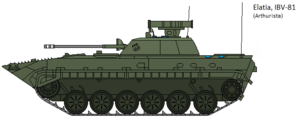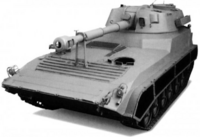IBV-75 & IBV-81 Infantry Fighting Vehicle
The IBV-75 and IBV-81 are types of infantry fighting vehicles in service with the Elatian Army. Essentially Elatia's version of BMP-1 and BMP-2, they share the same hull design with a few minor differences. They remain in service but are expected to be replaced by the IBV-05 design over the course of the next decades.
IBV-75
| IBV-75 Fighting Vehicle | |
|---|---|
 IBV-75 and IBV-75M3 vehicles | |
| Place of origin | |
| Service history | |
| In service | 1975-present |
| Used by | Elatian Army |
| Production history | |
| Designed | 1973-75 |
| Produced | 1975-present |
| Specifications | |
| Weight | 13.3 tonnes |
| Length | 6.74m |
| Width | 2.97 m |
| Height | 1.9 m |
| Crew | 3 |
| Passengers | 7-8 |
| Armor | Welded steel |
Main armament | 73mm smoothbore gun or 30mm autocannon |
Secondary armament | 7.65x53mm co-axial machine gun, anti-tank missiles |
| Engine | 6-cylinder diesel 300 bhp |
| Transmission | Torsion bars with hydraulic shock absorbers |
Operational range | 600km on roads |
| Speed | 65 kph on roads |
The IBV-75 is an Elatian infantry fighting vehicle, which was placed into service in the mid-70's with the Elatian Army.
Elatia's disastrous showing in the Second Elatian-Enyaman War involved many factors, but one was the significant inadequacy of mechanised infantry tactics. Still largely equipped with open-top half-tracks, Elatian mechanised forces were completely outmatched in the field. Later in the year, the Elatian Army obtained samples of the BMP-1 and decided to put a licensed version into production on an urgent basis.
The Elatian version's major difference with the BMP-1 is its lack of an autoloader - Elatian authorities regarded this gadget to be dangerous, overcomplicated and on the whole unneessary, as the gun's rate of fire is actually slightly higher when loaded by hand. The frontal aspect of the vehicle is resistant towards 23mm autocannons, although its flanks are only proof against small arms and shrapnel.
In upgraded form, the IBV-75 remains common in Elatian heavy units, supplemented by the newer IBV-81. In the future, it is likely to be replaced by the IBV-05.
IBV-75M1
The IBV-75M1 upgrade was implemented in the early-1980's. It added smoke grenade dispensers on the flanks of the turret. Fire control was also updated with an infrared searchlight and nightsight. The old AT-3 Sagger clone was replaced by a launch unit for the SACLOS TDM-80 anti-tank missile, which has a maximum range of 2km . It is essentially an infantry pintle mount which has been bolted onto the turret roof. As a result, in order for the missile to be fired, it is necessary for the tank commander to emerge from his hatch and take control of the launch unit. Reloading is likewise an awkward exercise.
Nevertheless, the TDM-80 upgrade represented a significant increase in firepower. In its most modern (post-2000's) incarnation, the TDM-80 has a range of around 2km and is equipped with a tandem warhead capable of penetrating 1,000mm of RHA. Even modern main battle tanks casually ignore such a threat at their peril.
Its launch unit could be detached from its mount atop the turret and carried by the vehicle's squad of dismounted riflemen.
IBV-75S
The IBV-75S is a variant of the IBV-75M1 optimised for the Elatian Naval Infantry. It features boat-like hull extensions in order to improve its floataion capabilities.
IBV-75M2
The IBV-75M2 upgrade was implemented in the mid-90's, following the sporadic irregular fighting which broke out subsequent to the Elatian Great Freeze against partisans and mutinying army and paramilitary units, which exposed the vulnerability of the original design to a multitude of threats. Accordingly, the M2 upgrade increased the protection level of the vehicle by applying applique strips of hardened steel armour on top of the flanks of the hull, with an air gap in between the hull surface and the strips. This conferred upon it all-round resistance against heavy machine gun fire. Unfortunately, as a result of the added weight, the vehicle loses its amphibious capability.
IBV-75M3
The IBV-75M3 is a refurbished and upgraded version of the IBV-75 in order to improve the vehicle's firepower at extended ranges by equipping it with a 30mm gun. It is fitted with a one-man turret with a licensed 2A75 autocannon, equipped with stabilisation gear, a new ballistic computer and laser rangefinder. The turret is capable of firing the TDM-80 wire-guided anti-tank missile.
Implemented at the same time as the IBV-75M4, the M3 was designed to be cheaper and is primarily intended for mobilisation units.
IBV-75M4
The IBV-75M4 program was implemented at the same time as the M3. Unlike the latter, these vehicles are intended for regular units and thus received a more expensive upgrade. They are fitted with a one-man turret featuring stabilised 30mm gun with a modern fire control system incorporating a laser rangefinder and thermal imager. These vehicles are equipped with four Kornet anti-tank missiles.
Variants of the IBV-75
The IBV-75 design is prolific in Elatian service and has spawned a number of variants. The most important of these include the following:
MO-75
The MO-75 is a self-propelled mortar variant, equipped with a 120mm tube which fires through a hatch in the raised roof of the passenger compartment.
MK-75
The MK-75 is a 122mm self-propelled gun which equipped the artillery complements of tank regiments. Following the 'brigadisation' reform of the Elatian Army in the 2000's, most of these vehicles have been placed into storage.
TC-75
The TC-75 tank destroyer entered service in the early-1980's to equip division-level anti-tank units and now serve at the brigade-level. It is armed with a twin-rail launcher for anti-tank missiles, together with an under-armour autoloader feeding from a magazine with eight spare rounds. Originally designed for the AT-6 Spiral, it is now typically armed with the new AT-9 Spiral-2. All vehicles in service have been upgraded with thermal imaging.
ADV-75
The ADV-75 was developed in the late-70's to equip the regimental air defence battalions of second line and low-readiness units as a cheap SPAAG substitute. Its primary armament is a twin-23mm mount bolted to the open roof of the vehicle. There is also space in the passenger compartment for a pair of MANPADS teams plus spare missiles. The high elevation angle of the anti-air gun makes these vehicles useful as fire support platforms in urban combat, although the gun crew is very vulnerable owing to the lack of armour protection.
RBV-75
The RBV-75 is a dedicated reconaissance version of the IBV-75. It is equipped with an enhanced communications suite, as well as space for dismounted scouts in the rear. The RBV-75B version, which carries the platoon commander, is equipped with a ground-surveillance radar, which is stored in a slot at the back of the turret. It pops up when needed and is retracted when it is not. All versions of the RBV have been upgraded with thermal imaging equipment in recent years.
IBV-81
| IBV-81 Fighting Vehicle | |
|---|---|
 IBV-81 | |
| Place of origin | |
| Service history | |
| In service | 1982-present |
| Used by | Elatian Army |
| Production history | |
| Produced | 1981-2010 |
| Specifications | |
| Weight | 14.3 tonnes |
| Length | 6.74m |
| Width | 3.15 m |
| Height | 2.45 m |
| Crew | 3 |
| Passengers | 7 |
| Armor | Welded steel |
Main armament | 30mm autocannon |
Secondary armament | 7.65x53mm co-axial machine gun, anti-tank missiles |
| Engine | 6-cylinder diesel 300 bhp |
| Transmission | Torsion bars with hydraulic shock absorbers |
Operational range | 600km on roads |
| Speed | 65 kph on roads |
The IBV-81 is an infantry fighting vehicle design in service with the Elatian Army, being a licensed version of the BMP-2. It is currently one of the two most common infantry fighting vehicles in service with regular army units and the Prophet's Guard, alongside the IBV-05.
Although originally introduced in the early-80's, production of the vehicle was severely disrupted by the Great Freeze. As a result, most of the vehicles currently in service were manufactured subsequent to 1990. Production ended in 2012. However, the machine tools needed to manufacture the vehicle remain stored away and may be put back into service rapidly, should the ability to produce simpler and more reliable combat vehicles in place of more modern and sophisticated models be needed.
The originally IBV-81 has a 2-man turret, equipped with a 30mm main gun. It has a roof-mounted anti-tank missile launcher for the TDM-80 SACLOS wire-guided missile, in common with the IBV-75M.
IBV-81M1
The IBV-81M1 is equipped with the same applique armour module as the IBV-75M2. As a result, in common with its predecessor, it loses its amphibious capability.
IBV-81M2
The IBV-81M2 has a new turret, equipped with thermal imaging sight and a quarter of AT-14 Kornet anti-tank missiles. It is commonly found in high readiness units.



